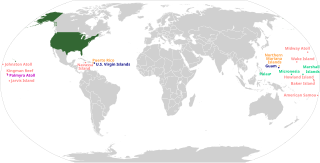A referendum is a direct and universal vote in which an entire electorate is invited to vote on a particular proposal and can have nationwide or local forms. This may result in the adoption of a new policy or specific law. In some countries, it is synonymous with a plebiscite or a vote on a ballot question.

"51st state", in post-1959 American political discourse, is a phrase that refers to areas or locales that are – seriously or facetiously – considered candidates for U.S. statehood, joining the 50 states that presently compose the United States. The phrase has been applied to external territories as well as parts of existing states which would be admitted as separate states in their own right.

General elections were held in Guam on November 7, 2006 in order to elect the Governor, all 15 seats in the Legislature and the federal delegate. There was also a double referendum on legalise slot machines at racing tracks and raising the age at which citizens could purchase and consume alcohol to 21.

General elections were held in Guam on November 5, 2002 in order to elect the Governor, all 15 members of the Legislature and the Federal delegate to the US Congress. There was also a referendum on raising the age at which alcohol could be bought and consumed to 21. The proposal was rejected by voters.
Abortion in Liechtenstein is illegal in almost all circumstances and is punishable by prison terms for the woman and the physician. An attempt to legalize it in 2011 was defeated by voters. In April and November 2012, the Landtag failed to advance proposals to relax abortion laws.

A referendum on the islands' status was held in the Federated States of Micronesia on 21 June 1983. Voters were asked two questions. The first was on whether they approved of the Compact of Free Association between the FSM and the United States. The second was what their preference was if Free Association was rejected. Voters were presented with the option of independence or an alternative which they had to fill in on the ballot form.
A referendum on union with the Northern Mariana Islands was held in Guam on 4 November 1969. The proposal was rejected by 58% of voters due to fears about an increase in taxation. Despite the result, a similar referendum was held in the Northern Mariana Islands on 9 November in which 61% of voters supported union with Guam.
A referendum on the territory's status was held in Guam on 4 September 1976. Voters were presented with a range of options, with "improved status quo" receiving the support of 58%.
A referendum on legalising casinos and slot machines was held in Guam on 16 April 1977, alongside elections to a Constitutional Convention and the Board of Education.
A two-part referendum was held in Guam on 4 August 1979. A proposed new constitution was rejected by 82% of voters, whilst a law introducing the death penalty was rejected by 53% of voters. In August 1987 a referendum was held on another proposed constitution, with each chapter voted on separately. Two chapters were rejected by voters, resulting in a second referendum in November in which both were approved.
A referendum on the territory's status was held in Guam on 4 September 1982. It was held after a referendum in January had resulted in none of the options presented to voters receiving a majority in favour. This time only two options, becoming a US commonwealth or a US state, were offered to voters, with 73% voting in favour of the former. However, the territory has still not achieved commonwealth status.
A referendum on introducing balanced budgets was held in Guam on 1 November 1986. Although more voters voted "yes" than "no", the Santos Amendment had required that the referendum required at least 50% of all votes in favour to pass. As a result, the proposal was rejected.

An unofficial referendum on integration with Guam was held in the Northern Mariana Islands on 27 October 1963. Although the proposal was approved by voters, the islands were not integrated.

A referendum on the islands' status was held in the Northern Mariana Islands on 5 February 1961. Although 65% of voters supported integration with Guam, the United States did not integrate the islands.

A referendum on the islands' status was held in the Northern Mariana Islands on 9 November 1969. For the fourth time since 1958 a majority of voters supported integration with Guam. However, a referendum held in Guam on 4 November on integration with the Northern Mariana Islands had been rejected by 58% of Guamanian voters.

A referendum on becoming a US commonwealth was held in the Northern Mariana Islands on 17 June 1975. The proposal was approved by 79% of voters. As a result, the United States Congress approved the change of status on 24 March 1976.
A referendum on legalising slot machines at greyhound racetracks was held in Guam on 5 January 2008. The proposal was rejected by 63% of voters.
A referendum on a new constitution was held in Guam on 8 August 1987. Instead of passing the whole constitution as a unit, voters chose to approve each chapter of the document individually. With a low turnout of 39%, all chapters were approved except for Chapter I on relations with the United States and Chapter VII on Chamorro relations and immigration. Modified versions of these rejected chapters would be accepted in a referendum later the same year.

A referendum on political reforms was held in Andorra on 16 January 1978. Voters were presented with two options, but the none of the above option received the most votes.
General elections were held in Guam on 6 November 1984 to elect the Legislature, the islands' delegate to the United States House of Representatives, Commissioners, Assistant Commissioners and the Territorial School Board. Voters also voted on three referendum questions. Primary elections had been held on 1 September.





